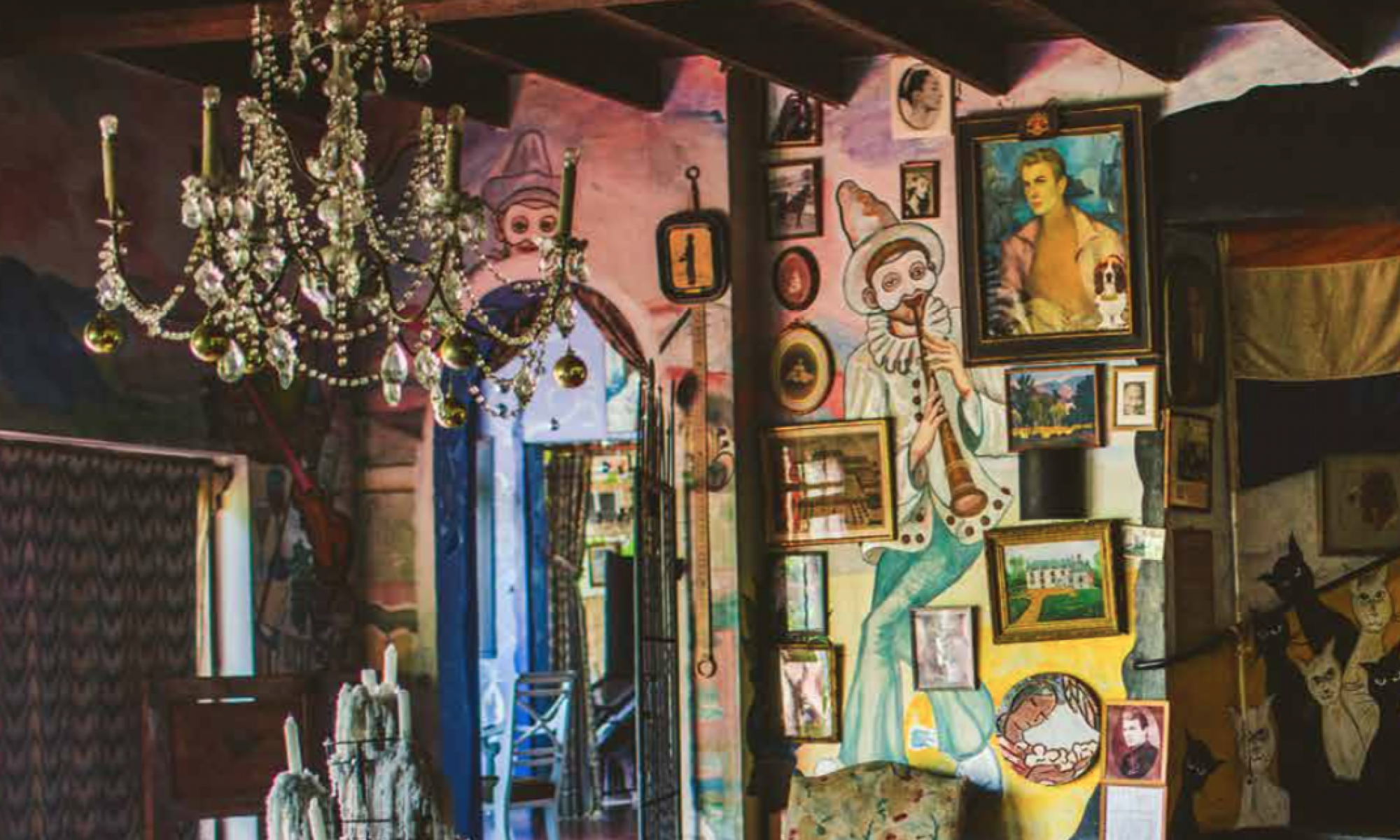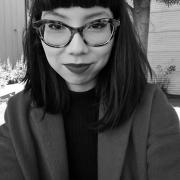Anti-hotel: A Folly in Five Tropes [FULL ARTICLE]
1. ‘… backed by jungle and all that goes with it! Not a boutique or starred emporium. If expecting a regular hotel experience, best look elsewhere.’ – Helga’s Folly [1]
In the city of Kandy, Sri Lanka, two mildly voyeuristic loci of touristic renown persist. One is the Temple of the Tooth, with the reliquary dente ensconced beside the central lake. The other is Helga’s Folly, unrelentingly promoted as an anomalous Wunderkammer up in the hills (must visit, if not stay). The Folly is ever bracketed: between neat synopses, the token oddity of dog-eared travel guides, splayed over hypersaturated magazine spreads, elsewhere the subject of frothy and undulous blogger interviews. None of these off-the-beaten-path narratives orbit too closely around the residence’s aesthetic sedimentation, a perplexing miasma of paintings, invited defacements, photographs and ephemeralia en masse. This is likely because the art withdraws into marginal caricature, cowed beneath a grand spectacle of eccentric archetypes … a crescendo peaking in the owner herself, Madam Helga de Silva Blow Perera.
2. ‘… a junkman’s paradise of faded luxury.’– Atlas Obscura [2]
As portended, the exterior resembles a tropical bunker in the throes of an unbridled mural effluvium. The Folly is sluggishly lit within, some rooms barely illumined by sepulchral candles, or via the muddied spectra of intermingling coloured bulbs. Pagan leitmotifs occupy ceilings and creep up walls in the guise of lunar cycles, woodland effigies and other varieties of mysterious anima. There is a persistent outbreak of daubed foliage tableaux over black, as well as a memorable swathe of nauseous green. Unfortunately, the overall effect is only momentarily gothic. A Halloween-esque mania affixes rubbery skeletons alongside blinking LEDs, crowned in the dust of perennial Christmas garlands. At one stairway landing, the celestial nymphs of the Sigiriya rock fortress have been recreated in a haphazard mimesis. The original fresco remains a Sri Lankan cultural icon, sustaining an otherworldly frisson despite the queuing hordes that ogle daily. Here, its derivative jostles with bug-eyed Alice in Wonderland caricatures and notables from the Wind in the Willows oeuvre, bathed in nightclub-blue light. Schizoid yet genteel, this painted amalgamation of cultures pop, high, low, foreign and endemic feels collectively naive. Artists who stay longer term can add to these strata, resulting in a crowdsourced culpability, a place drowning in the visual crust of unmoderated pluralities.
3. ‘… the empty, barely-lit corridors are chilling if you’re the only resident for the night.’ – Condé Nast Traveller India [3]
At the end of the seemingly interminable corridor, there is the second chandelier, sending a feeble wash across dilated walls. It emits a brittle chatter from all the way down there, arrhythmic outcries along a pendulous sway. There is no visible agent responsible for this kinesis, no source to flush out from behind threadbare spookiness; this ghost house alleged, possessed of diabolical light fittings. At the terminus of passage, a door announces itself, a rectangular abscess that bloats externally. The ceiling shrinks back from jungle canopy, and there’s that so-called ‘guardian fairy’ at repose, an attraction popularly described in terms of a delightful whimsy. Up close, the bulging, ovoid eyes of the sculpture connote something other. With waxy insidiousness, this same countenance universally leers through a frenzied mutiny of orbital lasers that pierce night skies. This is the ‘tall grey’ of the psychedelic trance visual lexicon, a mainstay of international drug-trip iconography. In those settings, patrons inevitably encounter real or hallucinated dioramas resplendent with this echoed face, which fills the vacant strips between trees, but is a face which never emerges corporeally.
4. ‘Guests over the years have included Vivien Leigh, Peter Finch, Sir Laurence Olivier, William Holden, Gregory Peck, Sir Alec Guinness, and Zandra Rhodes.’ – The Daily Beast [4]
Helga’s Folly revels in its celebrity shtick, cloyed by a salon hang of portraiture overflowing with filial intrigue. The walls are faceted by a multitude of these photographs, tessellating into the Folly’s society cachet, a self-mythologising family nexus made legible. Le Corbusier presides over dinner in one corner, for example. In this photo, he is accompanied by Helga’s aunt Minnette de Silva, his student and an architectural luminary in her own right. Proximally, there is another young woman imaged—a daughter, perhaps—clutching a rifle, laconic grin cemented, beret cocked to the side, as she leans against a tree. The food arrives with surreal pomp, segments domed atop a novelty fish-shaped platter. Drinks accompany in leaden, baroque goblets. A private tour group passes with smartphones aloft, nodding erratically through the monologue espoused by their guide. Their eyes skim over framed newspaper clippings bearing Helga’s handwritten annotations. Her marks and her likeness are ubiquitous throughout the Folly, signalling always towards the nucleus of this fantasia: its hotelier and protagonist.
5. ‘I knew then that I had found my artist. I wrote to the professor, asking her if she would consider doing a portrait of a woman on a hill in Kandy.’ – ‘Interview: Helga Perera’ [5]
Named eponymously for the artist, the Jane Lillian Vance Grotto swirls with visionary style, its murals florid and thick with raucous New Age spiritualisms. Its centrepiece is the portrait, a microcosm of the aforementioned pastiche, clad in an ostentatious golden frame. The canvas brims with prismatic hummingbirds, clustered flowers, heliotropic patterning and a tattooed skull. Helga occupies the centre, one arm flung out to mantle these glyphs. This deportment is replicated throughout the residence and in the abundance of press photos online, plumed Philip Treacy hat and bespoke choker consistent flourishes. Small vacillations do occur in Helga’s roster of auxiliary props. These are sartorial gestures made with equivalent panache to an Iris Apfel or Little Edie persona. Chintzy tulle winks at an audacious collar, or the parabola of a fan grazes demurely sealed lips. There is a tendency towards immaculate coiffure, worn with huge, impenetrable sunglasses. The woman on the hill retains a charismatic allure, whereas her Folly seems exhausted by this era of spoof tourism and trite, online bucket-listings.
[1] ‘Amenities and Gallery. Helga’s Folly – A Sri Lankan Home’, helgasfolly.com/amenities-and-gallery/; accessed 7 July 2019.
[2] ‘Helga’s Folly’, Atlas Obscura, atlasobscura.com/places/helga-s-folly; accessed 7 July 2019.
[3] Kinita Shenoy, ‘Helga’s Folly: Sri Lanka’s Own Hotel California’, Condé Nast Traveller India, 24 October 2018, cntraveller.in/story/helgas-folly-sri-lankas-own-hotel-california/; accessed 7 July 2019.
[4] Tom Skyes, ‘The Amazing Life of Helga Blow, Sri Lanka’s Last Great Eccentric’, The Daily Beast, 2017), thedailybeast.com/the-amazing-life-of-helga-blow-sri-lankas-last-great-eccentric; accessed 7 July 2019.
[5] Ahila Thillainathan, ‘Interview: Helga Perera’, Perspectives Quilt (blog), 31 August 2016, perspectivesquilt.com/2016/08/31/interview-helga-perera; accessed 7 July 2019.
The publisher wishes to note that several words were inadvertently omitted from the essay ‘Anti-hotel: A Folly in Five Tropes’ on pp. 66–69 in the print version of issue (56.1: Outside). As such, the complete essay has been made available here on the Art + Australia website. The publishers and editors extend their apologies to the author, Jessica Laraine Williams.
Image:
Erica Camille
Helga's Folly, 2014
Courtesy of Erica Camille Courtesy of the artist and the National Portrait Gallery, Canberra



%20*mimesis-itok=0oabei4O.jpg)